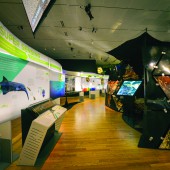Life at the Limits Museum Exhibition by Michael Meister |
Home > Winners > #41310 |
 |
|
||||
| DESIGN DETAILS | |||||
| DESIGN NAME: Life at the Limits PRIMARY FUNCTION: Museum Exhibition INSPIRATION: When designing, we thought first of what excites our visitors and ignites their curiosity. Reactions to past exhibitions focused on poisonous animals, tiny creatures, and other distinct subsections inform us that visitors love animal stories: in depth looks at unique or extreme animals. This motivated us to design an exhibition around "super powered" animals, that have adapted to environments far outside our everyday experience, a topic rich with stories of extraordinary creatures. UNIQUE PROPERTIES / PROJECT DESCRIPTION: Life at the Limits celebrates a diverse array of animals with extreme adaptations. It is broad in its coverage of hundreds of creatures and immersive design elements, which combine fabric, light, air blowers, double sided projection, smelling stations, sound boards, touchable, oversized models, live specimens, and motion tracking games. Many intersecting panels, curved in a mobius shape to represent the cycle of life, unite it all, guiding visitors through sections organized by life function. OPERATION / FLOW / INTERACTION: An outside video and the title panel preview content and introduce visitors to the exhibition's mascot, the tardigrade. The inner entrance's film and seating area act as a transition and again incorporate the tardigrade as supersized models. The exhibition proper flows along continuous, mobius strip panels, supplemented by vignettes. In the center is an immersive, walk in cave environment. An ending section provides thematic closure and ties back to the tardigrade with more supersized models. PROJECT DURATION AND LOCATION: The project was conceived and carried out in New York City beginning in November, 2013. Production finished and the exhibit opened in April, 2015. Life at the Limits will close January, 2016 and then leave the American Museum of Natural History as a touring exhibition. FITS BEST INTO CATEGORY: Interior Space and Exhibition Design |
PRODUCTION / REALIZATION TECHNOLOGY: We designed and fabricated the mobius strip panels entirely in house. Its graphics and text are printed on an acrylic substrates, which are supported by metal plates anchored in wood fins, and internally lit by warm and cool LED lights on dimmers. Animal models, an exhibition mainstay, were based on museum specimens, which we photographed extensively to determine size, color, proportion, and texture. The models were constructed from fiberglass and resin, with metal armatures. SPECIFICATIONS / TECHNICAL PROPERTIES: Exhibition is housed in an 8,500 square foot gallery space with 16 foot ceilings. TAGS: Natural History, American Museum of Natural History, Science, Biology, Exhibition, Museum, Life at the Limits, Evolution, Adaptation, Animals RESEARCH ABSTRACT: We used studied scientific information, public spaces, and visitor surveys to determine factual content, design inspiration, and public interest for the exhibition. Visitor response to an exhibition on "extreme creatures" was comparable to that of past popular exhibitions, indicating a strong response. The subtopics "extremophiles& CHALLENGE: We linked disparate animal stories by designing a segmented mobius panel. Our budget forced us to scale back stadium seating we had wanted to place in the exhibition and use benches instead, placing models we had intended to embed at floor level, to capture children’s attention. We abstracted our cave environment to make it less obstructive, creating a geometric exterior, printed with cave images. To balance the mobius band's brightness with the darker vignettes, we used dimmers. ADDED DATE: 2015-05-27 16:32:12 TEAM MEMBERS (16) : Sr. VP, Exhibitions: David Harvey, Managing Sr. Dir.: Melissa Posen, Dir. Design, Exhibition Dept.: Michael Meister, Exhibit Designer: Cine Ostrow, Lighting Designer: David Clinard, Dir. Graphic Design: Catherine Weese, Dir. Media: Helene Alonso, Dir. Prod.: Dean Markosian, Sr. Dir. Editorial: Lauri Haulderman, Exhibition Fabricator: Heartland Scenic Studios, Graphics Prod.: Color Edge, AMNH Fabrication Team, AMNH Media Design Team, AMNH Graphics Design Team, AMNH Editorial Team and Rosebrand Scenic Supplies IMAGE CREDITS: Image #1: Photographer Denis Finnin, Getting Started, 2015 Image #2: Photographer Denis Finnin, Tardigrades at Entrance, 2015 Image #3: Photographer Denis Finnin, Movement Section with Specimens, 2015 Image #4: Photographer Denis Finnin, Sensing Section and Cave, 2015 Image #5: Photographer Denis Finnin, Temperature, Camouflage Sections with Models, 2015 |
||||
| Visit the following page to learn more: http://www.amnh.org/ | |||||
| AWARD DETAILS | |
 |
Life At The Limits Museum Exhibition by Michael Meister is Winner in Interior Space and Exhibition Design Category, 2015 - 2016.· Read the interview with designer Michael Meister for design Life at the Limits here.· Press Members: Login or Register to request an exclusive interview with Michael Meister. · Click here to register inorder to view the profile and other works by Michael Meister. |
| SOCIAL |
| + Add to Likes / Favorites | Send to My Email | Comment | Testimonials | View Press-Release | Press Kit |
Did you like Michael Meister's Interior Design?
You will most likely enjoy other award winning interior design as well.
Click here to view more Award Winning Interior Design.








